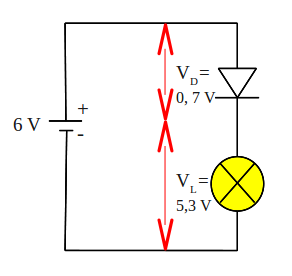Break down voltage diode, or voltage drop diode
Break down voltage or voltage drop diode is the minimum voltage on diode to electric current can flow.
A diode is not working like a resistor, that can easily a current of electricity that is charged to him. Diodes have a voltage drop, if value of applied voltage is less than the break-down voltage, the diode will not drain electrical current.
A given forward bias diode, has a voltage drop of about 0.7 V. In other words, if a given diode voltage is less than 0, 7 V, the diode will not drain the electrical current. And voltage is 0.7 V, will be a fixed voltage diode (VD) in the circuit.

Look the picture above, battery voltage source is 6 V. Voltage source will be divided in two, that is voltage drop diode (VD) and lamp voltage (VL). Known diode voltage drop is 0.7 V, then lamp voltage is equal to 6 - 0.7 = 5.3 V.
A diode is not working like a resistor, that can easily a current of electricity that is charged to him. Diodes have a voltage drop, if value of applied voltage is less than the break-down voltage, the diode will not drain electrical current.
A given forward bias diode, has a voltage drop of about 0.7 V. In other words, if a given diode voltage is less than 0, 7 V, the diode will not drain the electrical current. And voltage is 0.7 V, will be a fixed voltage diode (VD) in the circuit.

Look the picture above, battery voltage source is 6 V. Voltage source will be divided in two, that is voltage drop diode (VD) and lamp voltage (VL). Known diode voltage drop is 0.7 V, then lamp voltage is equal to 6 - 0.7 = 5.3 V.






No comments
No spam, no active link, please ^_^